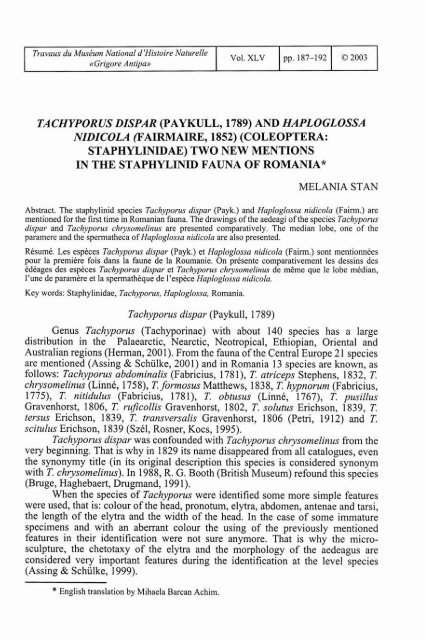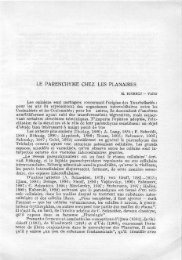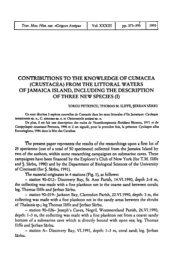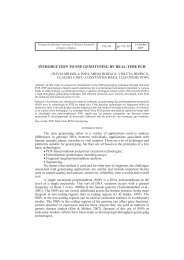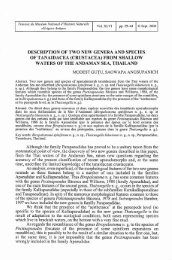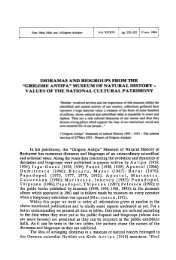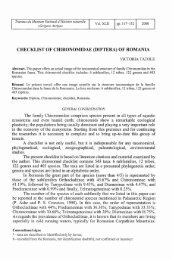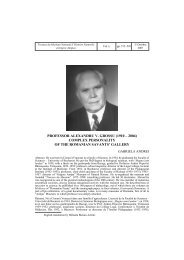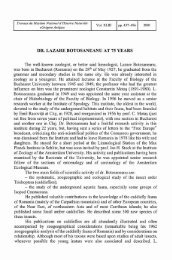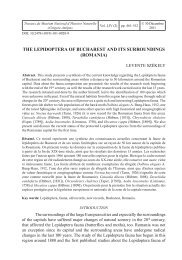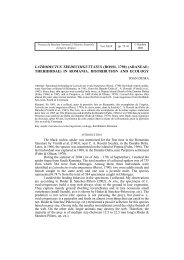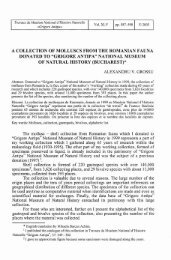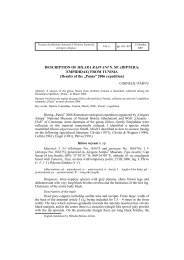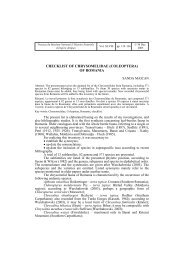TA CHYPORUS DISPAR (PAYKULL, 1789) AND ... - Travaux
TA CHYPORUS DISPAR (PAYKULL, 1789) AND ... - Travaux
TA CHYPORUS DISPAR (PAYKULL, 1789) AND ... - Travaux
Create successful ePaper yourself
Turn your PDF publications into a flip-book with our unique Google optimized e-Paper software.
<strong>Travaux</strong> du Musturn National dlHistoire Naturelle<br />
ct Grigore Antipa))<br />
Vol. XLV<br />
pp. 187-192<br />
0 2003<br />
<strong>TA</strong> <strong>CHYPORUS</strong> <strong>DISPAR</strong> (<strong>PAYKULL</strong>, <strong>1789</strong>) <strong>AND</strong> HAPLOGLOSSA<br />
NIDICOLA (FAIRMAIRE, 1852) (COLEOPTERA:<br />
S<strong>TA</strong>PHYLINIDAE) TWO NEW MENTIONS<br />
IN THE S<strong>TA</strong>PHYLINID FAUNA OF ROMANIA*<br />
MELANIA S<strong>TA</strong>N<br />
Abstract. The staphylinid species Tachypom dispar (Payk.) and Haploglossa nidicola (Fairm.) are<br />
mentioned for the first time in Romanian fauna. The drawings of the aedeagi of the species Tachyporus<br />
dispar and Tachyporus chrysomelinus are presented comparatively. The median lobe, one of the<br />
paramere and the spermatheca of Haploglossa nidicola are also presented.<br />
RCsum6. Les espices Tachyporus dispar (Payk.) et Haploglossa nidicola (Fairm.) sont mentionnkes<br />
pour la premiire fois dans la faune de la Roumanie. On pr6sente comparativement les dessins des<br />
Cdeages des esptces Tachyporus dispar et Tachyporus chrysornelinus de mdme que le lobe median,<br />
l'une de paramtre et la spermathique de I'espke Haploglossa nidicola.<br />
Key words: Staphylinidae, Tachyporus, Haploglossa, Romania.<br />
Tachyporus dispar (Paykull, <strong>1789</strong>)<br />
Genus Tachyporus (Tachyporinae) with about 140 species has a large<br />
distribution in the Palaearctic, Nearctic, Neotropical, Ethiopian, Oriental and<br />
Australian regions (Herman, 2001). From the fauna of the Central Europe 21 species<br />
are mentioned (Assing & Schulke, 2001) and in Romania 13 species are known, as<br />
follows: Tachyporus abdominalis (Fabricius, 1781), T. atriceps Stephens, 1832, T.<br />
chrysomelinus (LinnC, 1758), T. formosus Matthews, 183 8, T. hypnorum (Fabricius,<br />
1775), T. nitidulus (Fabricius, 1781), T. obtusus (LinnC, 1767), T. pusillus<br />
Gravenhorst, 1806, T. rujcollis Gravenhorst, 1802, T. solutus Erichson, 1839, T.<br />
tersus Erichson, 1839, T. transversalis Gravenhorst, 1806 (Petri, 191 2) and T.<br />
scitulus Erichson, 1839 (SzCl, Rosner, Kocs, 1995).<br />
Tachyporus dispar was confounded with Tachyporus chrysomelinus from the<br />
very beginning. That is why in 1829 its name disappeared from all catalogues, even<br />
the synonymy title (in its original description this species is considered synonym<br />
with T. chrysomelinus). In 1988, R. G. Booth (British Museum) refound this species<br />
(Bruge, Haghebaert, Drugmand, 1991).<br />
When the species of Tachyporus were identified some more simple features<br />
were used, that is: colour of the head, pronotum, elytra, abdomen, antenae and tarsi,<br />
the length of the elytra and the width of the head. In the case of some immature<br />
specimens and with an aberrant colour the using of the previously mentioned<br />
features in their identification were not sure anymore. That is why the microsculpture,<br />
the chetotaxy of the elytra and the morphology of the aedeagus are<br />
considered very important features during the identification at the level species<br />
(Assing & Schulke, 1999).<br />
* English translation by Mihaela Barcan Achim.
I88 MELANIA S<strong>TA</strong>N<br />
I studied 48 specimens of Tachyporus dispar and T. chrysomelinus from the<br />
collection of "Grigore Antipa" National Museum of Natural History from Bucharest<br />
(1 5 specimens were identified as Tachyporus chrysomelinus, the others were<br />
unidentified).<br />
The chetotaxy of the elytra were studied in Tachyporus chrysomelinus and<br />
Tachyporus dispar (Assing, Schiilke, 1999), besides other features of the external<br />
morphology. For certifying the identification of the two species of Tachyporus the<br />
genitalia of the male specimens were studied. After aedeagus separation, it was kept<br />
in a solution of KOH 10% for 24 hours, washed in distilled water and clarified in<br />
pure glycerine. The drawing of the aedeagi and of the elytron of the two species of<br />
Tachyporus were made using camera lucida. The same method was used for<br />
preparation and drawing of the aedeagus and the spermatheca of the Haploglossa<br />
nidicola.<br />
RESULTS<br />
From the 15 identified specimens, 12 belong to the species Tachyporus dispar<br />
and 3 specimens to the species Tachyporus chrysomelinus. From the 33 unidentified<br />
specimens, 28 belong to the species T. dispar and 5 specimens to T. chrysomelinus.<br />
Tachyporus dispar: 8 specimens, Azuga, leg. Ed. Fleck, (as Tachyporus<br />
chrysomelinus); 3 specimens, Schulergebirge (Cristianu Mare Mt. - Bragov), leg. Fr.<br />
Deubel, (as Tachyporus chrysomelinus); 1 specimen, Kapelenberg (Tbmpa-Bra~ov),<br />
leg. Fr. Deubel (as Tachyporus chrysomelinus); 18 specimens without data, leg. D.<br />
Kenderessy; 3 specimens without data, leg. Ed. Fleck; 7 specimens (6 d d , 1 0),<br />
Gale9 (Briidulet-Argeq), 7-21 VII 2001, leg. C. Pbrvu, with Barber traps placed in<br />
the heyfield.<br />
Tachyporus chrysomelinus: 1 specimen, Kapelenberg, leg. Fr. Deubel; 2<br />
specimens, Azuga, leg. Ed. Fleck; 4 specimens without data, leg. D. Kenderessy; 1<br />
specimen (d) Gale? (Briidulet-Argeq), 7-21 VII 2001, leg. C. Pbrvu, with Barber<br />
traps placed in the heyfield.<br />
DISCUSSIONS<br />
The chetotaxy of the lower-lateral margin of the elytron is different in<br />
Tachyporus dispar and Tachyporus chrysomelinus. In Tachyporus dispar there are 2<br />
setiferous punctures, one of them with a bigger outer seta and one with an inner<br />
smaller seta, so there are 4 setiferous punctures on the lower margin of the elytron<br />
(Fig. 1 A). In T. chrysomelinus there is a single setiferous puncture with an outer big<br />
seta, so there are only 3 setiferous apical punctures (Fig. 1 B). The number of the<br />
discal and sutural setiferous punctures can vary in different specimens of<br />
Tachyporus dispar and T, chrysomelinus.<br />
The study of the aedeagus in dorsal view confirms the identification. In<br />
Tachyporus dispar the "S"- shaped sclerite of the internal sac is longer than the<br />
apical lobes of the parameres (Fig. 1 C), while in Tachyporus chrysomelinus the<br />
sclerite of the internal sac is shorter than the apical lobes of the parameres (Fig. 1 D).<br />
The distribution of the species Tachyporus dispar is in Europe, Canada, USA<br />
(Herman, op. cit.).
<strong>TA</strong><strong>CHYPORUS</strong> <strong>DISPAR</strong> <strong>AND</strong> HAPLOGLOSSA NIDICOLA (COLEOPTERA) IN ROMANIA<br />
Fig. 1 - A, Tachyporus dispar (Payk.), left elytron; B, Tachypow chrysomelinus (L.), left elytron (a,<br />
sublateral setiferous puncture; b, discal internal setiferous punctures; c, discal median setiferous<br />
puncture; d, discal external setiferous punctures; e, sutural setiferous punctures; f, lateral setiferous<br />
punctures; g, apical setiferous punctures); C, Tachyporus dispar, aedeagus (dorsal view); D,<br />
Tachyporus chrysomelinus, aedeagus (dorsal view). Scale: A, B, 0.5 mm; C, D, 0.25 mm.<br />
Haploglossa nidicola (Fairmaire, 1852)<br />
In Coleopterorum Catalogus Staphylinidae VI (Bernhauer, Scheerpeltz,<br />
1926) 9 species of the genus Haploglossa Kraatz, 1856, (=Microglotta Kr.,<br />
Microglossa Muls. & Rey) with a Palaearctic distribution are mentioned.<br />
As yet, from Romania 3 species of Haploglossa (Aleocharinae, Oxypodini)<br />
cited as the genus Microglossa are known, as follows: Haploglossa gentilis (Markel,<br />
1844), H. marginalis (Gravenhorst, 1806) and H. villosula (Stephens, 1832)<br />
(=H. pulla Gyllenhal, 1827) (Kuthy, 1897; Petri, op. cit.).<br />
The species of the genus Haploglossa live in bird nests. Haploglossa nidicola<br />
is a typically nidicolous staphylinid and as most of the aleocharines is a predator<br />
species. It was remarked the presence of a large number of specimens of<br />
189
190 MELANIA S<strong>TA</strong>N<br />
Haploglossa nidicola in the nests of Riparia riparia and Merops apiaster (KriStofik,<br />
MaSan, Sustek, 1996). Its presence both in the nests of Merops apiaster and of the<br />
Riparia riparia can be explained by the similitude between these nests (similar<br />
location, internal environment).<br />
The description of the species Haploglossa nidicola (in Ganglbauer, 1895)<br />
and the identification keys for the genus Haploglossa (in Lohse, 1974) permitted the<br />
identification of the species: body colour brown-blackish; head and pronotum<br />
almost entirely glossy; the first three articles of the antenna, palpi and legs yellow-<br />
reddish; the short antennae has the 3rd article as long as the 4th one, the last one being<br />
narrow as the 5th article and slightly tranverse; articles 5-10 clearly transverse; head<br />
with a greater punctuation than that of the pronotum; pronotum with the distance<br />
between punctures obviously smaller than the diameter of the puncture; punctuation<br />
of pronotum finer than that of the head and more intens than that of the elytra; red<br />
coloured elytra with the bases and lateral margins blackish, with a denser<br />
pubescence than that of the pronotum. Length: 2.5-3 mm.<br />
Material. 9 specimens (6 99, 3 dd), collected by Dr. Angela Petrescu, the<br />
ornithologist of the museum, from the nests of Merops apiaster, from Friteqti<br />
(Giurgiu County) on August 2Sth, 2000.<br />
For pointing out the median lobe, the parameres were separated, they being<br />
very developed, covering the median lobe as the valves of a shell (Fig. 2).<br />
Fig. 2 - Haploglossa nidicola. (Fainn.): A, B, median lobe (ventral and lateral view); C, paramera<br />
(internal face); D, spermatheca. Scale: 0.1 mm.
<strong>TA</strong><strong>CHYPORUS</strong> <strong>DISPAR</strong> <strong>AND</strong> HAPLOGLOSSA NIDICOLA (COLEOPTERA) IN ROMANIA 191<br />
Distribution. Central and North Europe, Siberia (Horion, 195 1).<br />
Coleopteran collection of "Grigore Antipa" National Museum of Natural<br />
History contained only the species Haploglossa gentilis and Haploglossa villosula,<br />
thus the species Haploglossa nidicola enriching this collection.<br />
ACKNOWLEDGEMENTS<br />
1 want to thank to Dr. Michael Schiilke (Berlin) for the papers and for the information on the<br />
species Tachyporus dispar from Romania. Also I thank to Mrs Rodica Serafim, curator of the<br />
coleopteran collection, to Dr. Comeliu Pdrvu for the specimens of Tachyporus collected from Gale?<br />
(Argev County) and to Dr. Angela Petrescu for the specimens of Haploglossa nidicola. 1 want to thank<br />
to Mrs Aurora Dinu for the drawings in China ink. Also I want to thank to the anonimous referees for<br />
their commentaries on the manuscript and the editorial advice.<br />
<strong>TA</strong><strong>CHYPORUS</strong> <strong>DISPAR</strong> (<strong>PAYKULL</strong>, <strong>1789</strong>) $I HAPLOGLOSSA NIDICOLA<br />
(FAIRMAIRE, 1852) (COLEOPTERA: S<strong>TA</strong>PHYLINIDAE) DOUA NO1 SEMNALARI<br />
iN FAUNA DE S<strong>TA</strong>FILINIDE A ROMANIEI<br />
REZUMAT<br />
Speciile Tachyporus dispar (Payk.) $i Haploglossa nidicola (Fairm.) sunt semnalate pentru<br />
prima datl in fauna de stafilinide a Romlniei. in urma studiului caracterelor de morfologie externl $i a<br />
edeagurilor din cele 48 exemplare analizate, 40 apartin speciei Tacl~yporus dispar iar 8 exemplare<br />
apartin speciei Tachyporus chrysomelinus. Sunt prezentate desenele edeagurilor speciilor Tacl~.~ponrs<br />
dispar $i Tacl~yporus chrysomelinzcs. Au fost determinate ca Haploglossa nidicola 9 exemplare de<br />
stafilinide colectate de dr. Angela Petrescu, specialistul omitolog al muzeului, din cuiburi de Merops<br />
apiaster de la Frltevti (Giurgiu), la data de 28 VIll 2000. Sunt tigurate lobul median, o paramerl ~i<br />
spermateca speciei Haploglossa nidicola.<br />
LITERATURE CITED<br />
ASSING, V., M. SCHULKE, 1999 - Supplemente zur mitteleuropaischen Staphylinidenfauna<br />
(Coleoptera, Staphylinidae). Entomologische Blatter, 95 (1): 1-3 1.<br />
ASSING, V., M. SCHULKE, 2001 - Supplemente zur mitteleuropaischen Staphylinidenfauna<br />
(Coleoptera, Staphylinidae). 11. Entomologische Blatter, 97 (2-3): 12 1- 176.<br />
BERNHAUER, M., 0 . SCHEERPELTZ, 1926 - Staphylinidae VI. Pp. 500-988. In: Coleopterorum<br />
Catalogus. W. Junk Berlin W. 15.<br />
BRUGE, H., G. HAGHEBAERT, D. DRUGM<strong>AND</strong>, 1991 - 27 taxa de la famille des Staphylinidae<br />
nouveaux pour la faune belge (Coleoptera). Bulletin Annales de la Societe Royale<br />
Belge d'Entomologie, 127: 45-70.<br />
GANGLBAUER, L., 1895 - Die Kafer von Mitteleurope. Druck und verlag von Carl Gerold's sohn<br />
Wien 2 (2): 1-77 1.<br />
HERMAN, L., 2001 - Tachyporinae group. Pp. 651-1066. In: Catalog of the Staphylinidae (Insecta:<br />
Coleoptera). 1758 to the end of the second millennium. Bulletin of the American<br />
Museum of Natural History, New York. 42 18 pp.<br />
HORION, A., 1951 - Staphylinidae. Pp. 102-203. In: Verzeichnis der Kafer Mitteleuropas<br />
(Deutschland, Osterreich, Tschechoslovakei) mit kurzen faunistischen Angaben,<br />
Alfred Kemen verlag. 536 pp.<br />
KRI~TOF~K, J., P. MASAN, Z. SUSTEK, 1996 - Ectoparasites of bee-eater (Merops apiaster) and<br />
arthropods in its nest. Biologia, Bratislava, 51 (5): 557-570.
192 MELANIA S<strong>TA</strong>N<br />
KUTHY, D., 1897 - Ord. Coleoptera. In: A Magyar Birodalon bllatvilaga (Fauna Regni Hungariae),<br />
A.K.M. TermCssettud. Thrsulat, Budapest: 1-214.<br />
LOHSE, G. A., 1974 - Staphylinidae I1 (Hypocyphtinae und Aleocharinae). In: H. Freude, K. Harde &<br />
G. A. Lohse, Die Kafer Mitteleuropas, Goecke & Evers, Krefeld, 5: 1-304.<br />
PETRI, K., 1912 - Siebenbiirgens Kaferfauna auf Grund ihrer Erforschung bis zu Jahre 1911.<br />
Sieberbiirgischen Vereins fur Naturwissenschaften zu Hermannstadt: 1-376.<br />
SZEL, G., I. ROSNER, I. KOCS, 1995 - Contributii la cunoavterea coleopterelor din Transilvania<br />
(Rombnia) pe baza colect5irilor din ultimii ani. Acta Hargitensia 11, 9: 80-83. (in<br />
Romanian)<br />
Received: January 10, 2003<br />
Accepted: March 12, 2003<br />
Muzeul National de Istorie Natural6 ,, Grigore Antipa"<br />
30s. Kiseleflnr. 1, 011341 Bucure~ti 2, Rominia<br />
e-mail: mstan@antipa.ro


